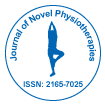Medial Tibial Stress Syndrome in Athletes: Diagnostic and Therapeutic Approach
Received: 06-Mar-2015 / Accepted Date: 09-Mar-2015 / Published Date: 16-Mar-2015 DOI: 10.4172/2165-7025.1000e138
360243Editorial
Although Medial Tibial Stress Syndromes (MTSS) also called shin splints, do not represent a clear diagnosis, it is generally accepted as a pathology which refers to an overuse injury causing tibial pain mainly in active people such as weight bearing athletes and military recruits [1]. It is characterized by chronic pain along the posteromedial tibial border which deteriorates with physical stress and may persist after exercise [2].
The pathophysiology of this nosological entity is not totally clarified. Tibial periostitis following long-lasting traction from toe flexors and the tibialis posterior muscle, elevated muscle compartment pressures in the lower leg and bony resorption that outpaces bone formation of the tibial cortex, have proposed as possible sources of MTSS [2-5].
The incidence of MTSS is estimated between 13% and 22% of running and dance injuries [3]. This ailment has been associated with the presence of several risk factors such as training errors, decreased hip internal range of motion, increased ankle plantar flexion, positive navicular drop, female gender, increased body mass and foot hyperpronation [6-13].
Diagnosis is based primarily on a thorough clinical history and a meticulous physical examination [1]. The pain which usually has a dull character is commonly located along the posteriomedial border of the middle to distal third of the tibial bone over a length of five or more consecutive centimetres [1,3]. A mild oedema or erythema in this painful area may also be present [14,15]. In severe cases pain may be manifested at rest and exacerbate with simple activities [16]. Neurovascular signs and symptoms are not commonly attributable to MTSS and when present, other pathologies such as cronic exertional compartment syndrome (CECS) or vascular deficiencies should be considered as the source of leg pain [3,14].
Differential diagnosis mainly includes CECS and tibial stress fractures [8]. Other likely causes of tibial pain such as muscle hernias or other muscular and tendinous abnormalities, spinal pathology and radiculopathy, nerve entrapment syndromes and cellulitis may overlap with MTSS. Additionally the presence of less common ailments such as a malignancy or infection, vascular occlusion or deep vein thrombosis should also be ruled out [1,14,16].
The necessity of diagnostic imaging studies in the presence of a thorough clinical examination is debatable [13,16]. However, plain radiography may be necessary for the detection of a series of other ailments which cause leg pain such as tibial stress fractures, bone tumours, or soft-tissue calcification [17].
Computerized Tomography (CT), which depicts cortical abnormalities and Magnetic Resonance Imaging (MRI) which is a very useful tool for the manifestation of soft tissue lesions, are tests that play a major role in MTSS differential diagnosis [17].
A particularly important examination with definite diagnostic value is bone scintigraphy, as in MTSS it will demonstrate increased bone activity along the tibial axis, whereas in a stress fracture it will reveal focal fusiform areas with high radiopharmaceutical intake [18].
Treatment is mainly non operative including several conservative therapeutic modalities. In the acute phase rest, ice and analgesics are strongly recommended [3]. Physical therapy includes a variety of therapeutic modalities with beneficial effects on various phases of the disease [13]. In a recent systematic review by Winters et al. [19] a number of Randomised Control Trials (RCTs) proposing several conservative means for the treatment of MTSS were analysed. Amongst them iontophoresis, phonophoresis, ice massage, ultrasound, acupuncture and specifically the periosteal pecking technique and extracorporeal shockwave therapy (ESWT) appear to be effective when confronting shin splints [19]. On the contrary, other non operative modalities such as low- energy laser treatment, stretching and strengthening exercises, and pulsed electromagnetic field therapy are not recommended for the treatment of this disease as their beneficial result has not been confirmed [19]. Other physical therapy approaches, more specifically the fascial distortion model and lower-leg Kinesio tape are suggested as a potential effective alternative methods for acute treatment of MTSS [5,20].
Surgical treatment which produces positive results to a significant extent ranging from 69% to 92%, is warranted for refractory cases [3,16]. This intervention includes posterior fasciotomy or removal of a periosteal strip from the posteromedial border of the tibia which reduces the traction over the periosteum. Both general and local anaesthesia techniques have been utilized [16,18,21].
Nevertheless the optimal therapeutic approach for this common source of leg pain has to be clarified. Future research on the field should undoubtedly lead to conclusions about methods that demonstrate clinical effectiveness as well as cost-effectiveness of MTSS treatment.
References
- Schulze C, Finze S, Bader R, Lison A (2014) Treatment of medial tibial stress syndrome according to the fascial distortion model: a prospective case control study. Scientific World Journal 2024:790626.
- Raissi GR, Cherati AD, Mansoori KD, Razi MD (2009) The relationship between lower extremity alignment and Medial Tibial Stress Syndrome among non-professional athletes. Sports Med ArthroscRehabilTherTechnol 1:11.
- Hamstra-Wright KL, Bliven KC, Bay C (2015) Risk factors for medial tibial stress syndrome in physically active individuals such as runners and military personnel: a systematic review and meta-analysis. Br J Sports Med 49:362-369.
Citation: Angoules AG (2015) Medial Tibial Stress Syndrome in Athletes: Diagnostic and Therapeutic Approach. J Nov Physiother 5:e138. DOI: 10.4172/2165-7025.1000e138
Copyright: © 2015 Angoules AG. This is an open-access article distributed under the terms of the Creative Commons Attribution License, which permits unrestricted use, distribution, and reproduction in any medium, provided the original author and source are credited.
Share This Article
Recommended Journals
51���ϳԹ��� Journals
Article Tools
Article Usage
- Total views: 17081
- [From(publication date): 4-2015 - Apr 29, 2025]
- Breakdown by view type
- HTML page views: 12250
- PDF downloads: 4831
